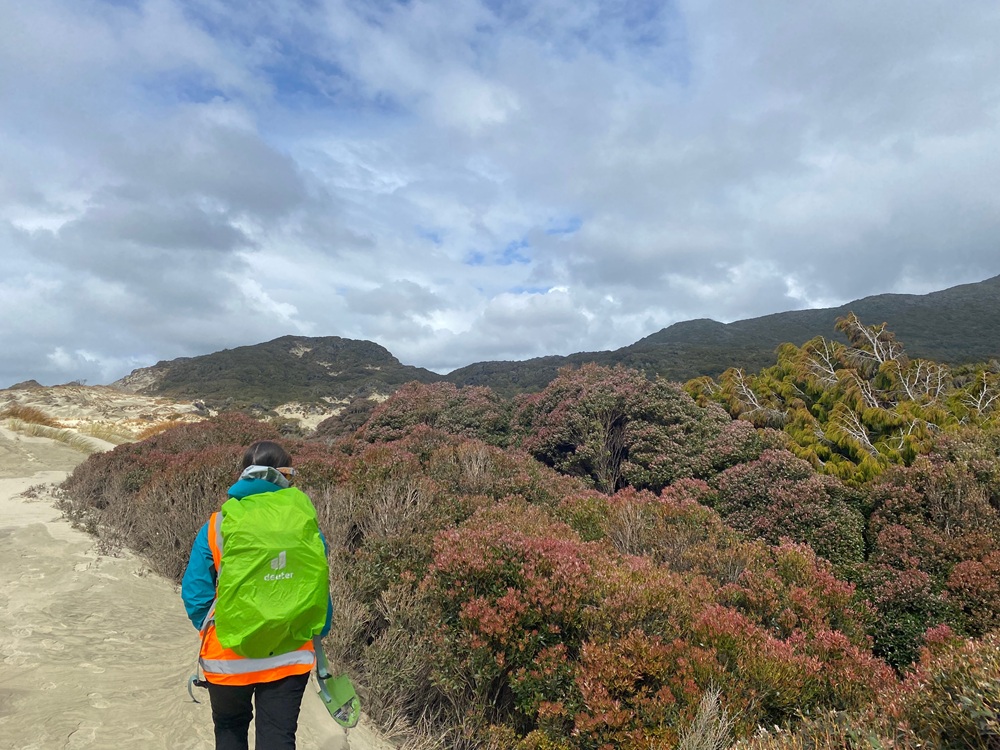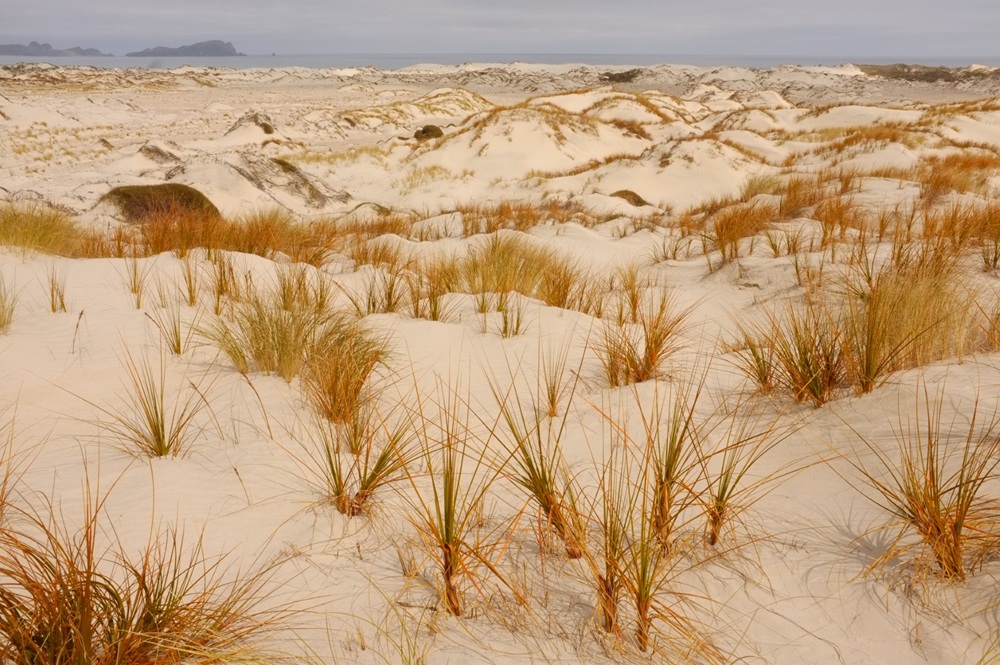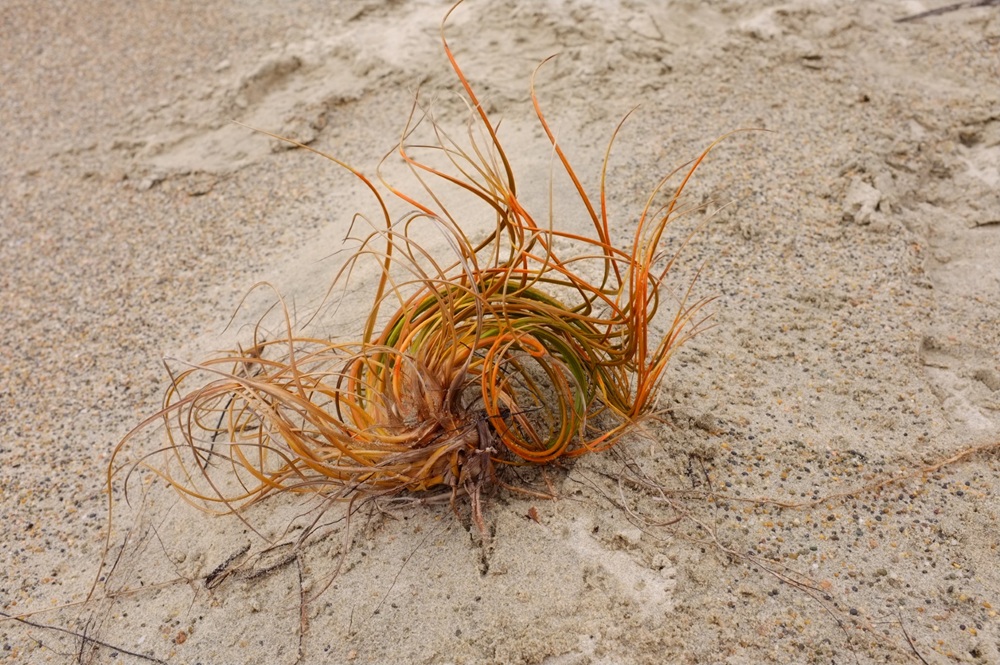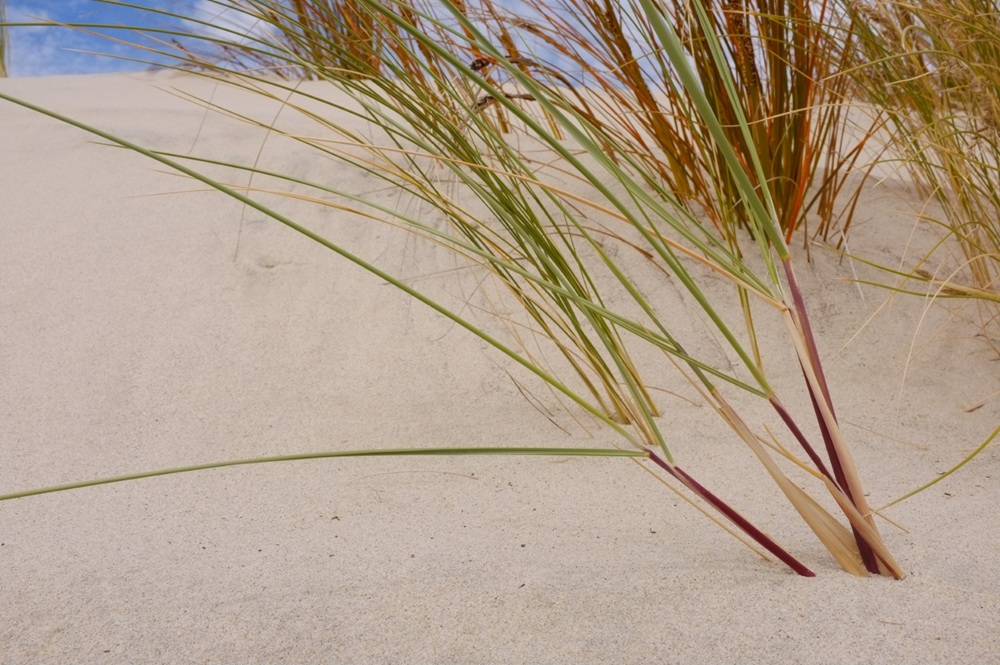Marram; Moresg: Freya and the New Zealand Problem; Rakiura

Julie Brominicks
It was a thick August day, warm but grey. In our friends’ garden near Machynlleth with the dogs at our feet, Freya Canham placed souvenirs from New Zealand where she’d just spent a year of her Earth Science degree, onto a round table.
A bowl of rock samples. Pressed ferns. She was talking us through photographs of a conservation project she’d been involved with when I got confused.
‘We were collecting marram from the strand-line. You had to get your eye in to make sure it was marram and not any other grass.’ I assumed I’d misheard the name of a southern-hemisphere plant but I was wrong. Freya was indeed referring to the marram grass so important to Welsh dune ecology; which in New Zealand is a problem.
Marram (moresg in Cymraeg and Ammophila arenaria in Latin) is native to Europe and North Africa.
It thrives, quickly sending up new shoots, when smothered in dry sand.
Rhizomes
Meanwhile its roots descend several metres in search of water, while rhizomes; the underground stems from which new roots and shoots sprout, extend horizontally for several metres.
‘The value of this grass as a natural sand-binder cannot be over-estimated; many thousands of acres of land on various parts of our coast are preserved from being overwhelmed of the driving sand solely by its agency.’ So wrote Charles Pierpoint Johnson in 1862 in ‘The Useful Plants of Great Britain.’
This sand-fixing quality is why landowners introduced marram to New Zealand in the 19th century; in order to prepare dunes for commercial forestry and agriculture. As is usually the case in such scenarios, the introduced species has become a pest. An irony not lost on Freya who ‘went off on a bit of a marram tangent’ when doing her A’ Level bee project a few years previously.
‘I was looking at how marram was used to weave bee skeps, and that here in Wales protections had to be put in place for fear that overharvesting the marram would make the sand dunes unstable.’ In Cymru it has always been valued.
In New Zealand, marram has spread a long way from the sites where it was planted. Its wind-blown seeds remain viable for decades and their partial burial stimulates growth. Having been spotted growing just above spring high-tide marks, it became evident to observers that during episodes of stormy seas and dune erosion, marram grass is also spread by the sea, in which the rhizomes washed into it by storms can survive for sixty days.

When deposited onto new shores, fresh growth sprouts from nodes in the rhizomes and fore-dunes develop. These stable fore-dune systems impede sand mobility and reduce sand in the dune hinterland to the eventual detriment of native species. Marram is threatening grasses like pīngao and spinifex used by Māori for weaving, and dune eco-systems which sustain shore-birds, invertebrates, geckos and skink (lizards).

While the long-term aim is to eradicate marram, the immediate focus is to protect sites where dune systems are still healthy.
Enter Freya, who volunteered at Mason Bay on Rakiura (Stewart Island.) ‘We were there a few weeks after a large storm had hit and a quick walk along the coast revealed little rafts of stranded marram rhizome that had washed off the coast of South Island and were already starting to sprout.’
This presents a challenge to the Rakiura Dune Restoration Programme which has been running for thirty years. ‘The dense marram vegetation provided perfect opportunities for non-native predators like cats to ambush kiwi’ explained Freya, adding that she was glad to have missed the years of herbicide spraying by conservationists to eradicate the marram. ‘Despite all the progress made so far, if those little rhizomes on the strandline go unchecked, marram from the mainland will recolonize the restored dunes.’
Freya’s job was to systematically survey the dunes and weed out any new marram seedlings or young plants. ‘If you were lucky that involved kicking a seedling out of the sand with the toe of your boot. If you weren’t so lucky you could end up spending an hour digging out a mature plant.’

To distinguish invasive marram from native tussock grass she and the other volunteers looked for the giveaway purple stems and green-blue leaves. ‘Against the golden sand, pink granite, and the yellow and orange native grasses, marram stood out as being conspicuously cool-toned.’
It was strange to be sat beneath our friends’ walnut tree in warm green Welsh weather looking at photos of pesky marram rhizomes trying to take root on a New Zealand beach.
Young Freya by contrast, was welcomed on those shores, but is back in Manchester now to finish her studies. She doesn’t know where her travels will take her next but travel she surely will.
References
Hilton, Mike, Konlechner, Teresa Maree, ‘The Rakiura Dune Restoration Programme (1999-2021) Lessons Learned from 21 Years of Operations, Monitoring & Research’, 2021
Johnson, Charles Pierpoint, ‘The Useful Plants of Great Britain’, 1862
Support our Nation today
For the price of a cup of coffee a month you can help us create an independent, not-for-profit, national news service for the people of Wales, by the people of Wales.




